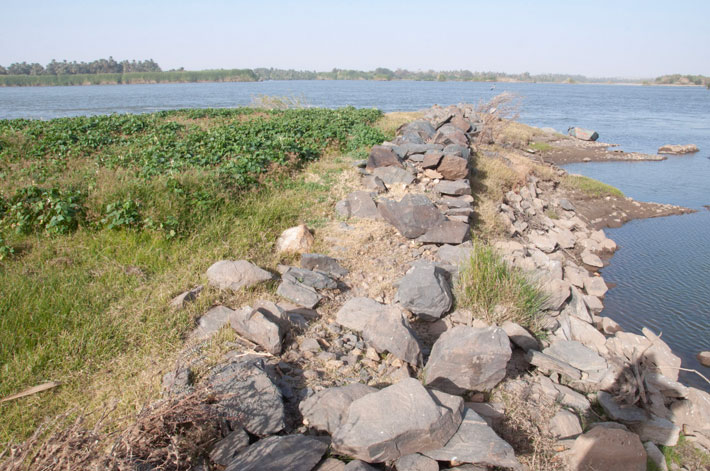Anthropology
Related: About this forumAncient Hydraulic Engineering Along the Nile River Examined
Thursday, June 15, 2023
Nile Stone Walls(University of Manchester)

Nile Stone Walls(University of Manchester)MANCHESTER, ENGLAND—According to a statement released by the University of Manchester, an international team of scientists employed satellite imagery, drone and ground surveys, and study of historical sources, including travelers’ diaries, maps, and early twentieth-century aerial photographs, to examine some 1,300 river groins, or stone walls constructed along the Nile River between the first cararact in southern Egypt and the fourth cataract in Sudan. Many of these structures are now submerged in the Aswan High Dam reservoir, or were built along Nile channels that are now dry. Dating of the walls indicates that some of them were built more than 3,000 years ago. Some of the larger ones measure more than 16 feet wide and 650 feet long, and would have directed the flow of water within the river and assisted with the navigation of rapids, facilitating travel between Egypt and Nubia. The study also indicates that the groins trapped silts during the annual inundation of the Nile, thus supporting agriculture without the need for further irrigation. “This incredibly long-lived hydraulic technology played a crucial role in enabling communities to grow food and thrive in the challenging landscapes of Nubia for over 3,000 years,” said Matthew Dalton of The University of Western Australia. Farmers in Sudanese Nubia continued to build river groins as recently as the 1970s, and still cultivate land formed by ancient walls, he concluded. Read the original scholarly article about this research in Geoarchaeology. To read about a device that Egyptians used to gauge and help predict the Nile's annual flooding, go to "The Ancient Promise of Water: The Limits of the Nile."
https://www.archaeology.org/news/11537-230615-nile-river-engineering
Judi Lynn
(162,406 posts)Friday, June 9, 2023
QUEBEC, CANADA—Fragments of quartz tools that may be 10,000 years old have been found near Philippe Lake in western Quebec, according to a report in The Globe and Mail. Archaeologist Ian Badgley of Canada’s National Capital Commission unearthed the tools at a settlement site originally thought to have been inhabited about 3,000 years ago. Badgley said that the tools suggest the site, situated at the confluence of three major river systems, was at the hub of a vast precontact communications and trade network used by the Kitigan Zibi, the Mohawk, and the Huron peoples. “Part of the deal was the trade of knowledge,” added Doug Odjick of the Kitigan Zibi Anishinabeg council. The tools are being dated at the University of Ottawa and compared with quartz objects recovered from a site in Pikwakanagan, located about 60 miles from Philippe Lake. “This will tell us more about who these people are, who they were related to, where they were living and how they moved around,” Badgley concluded. To read about a controversial study of marked bones unearthed in Canada's Bluefish Caves, go to "Standing Still in Beringia?"
https://www.archaeology.org/news/11495-230609-canada-quartz-tools
Judi Lynn
(162,406 posts)A.I. Identifies Four Nazca Geoglyphs in Peru
Friday, June 9, 2023
YAMAGATA, JAPAN—ArtNet News reports that four Nazca geoglyphs have been identified in Peru through the use of artificial intelligence by a team of researchers led by Masato Sakai of Yamagata University. Over a period of five years, the team members manually identified geoglyphs in aerial photographs of the Nazca plateau and confirmed many of them with onsite surveys. Then, the researchers collaborated with IBM to combine a kind of machine learning called deep learning and field surveys in the search for geoglyphs, in a process estimated to be 21 times faster than looking for them with the naked eye. The four newly found geoglyphs include a humanoid figure holding a club, a wide-mouthed fish, a pair of legs measuring 255 feet long, and a skeletal image of a bird. Read the original scholarly article about this research in Journal of Archaeological Science. For more on the Nazca Lines, go to "Partially Identified Flying Objects."
https://www.archaeology.org/news/11494-230609-peru-artificial-intelligence
tanyev
(44,544 posts)Moses, who grew up in Pharaoh's court, knew how it worked or enlisted people who knew how it worked. When they fled, he had a team that seized the controls of the lock. The iconic image of Moses stretching out his hands could have been signals to whoever was operating the controls. Drain out one level so the people can cross and then open the gates once your people are out, releasing the water onto the pursuing army.
My theory, which belongs to me, is mine. ![]()